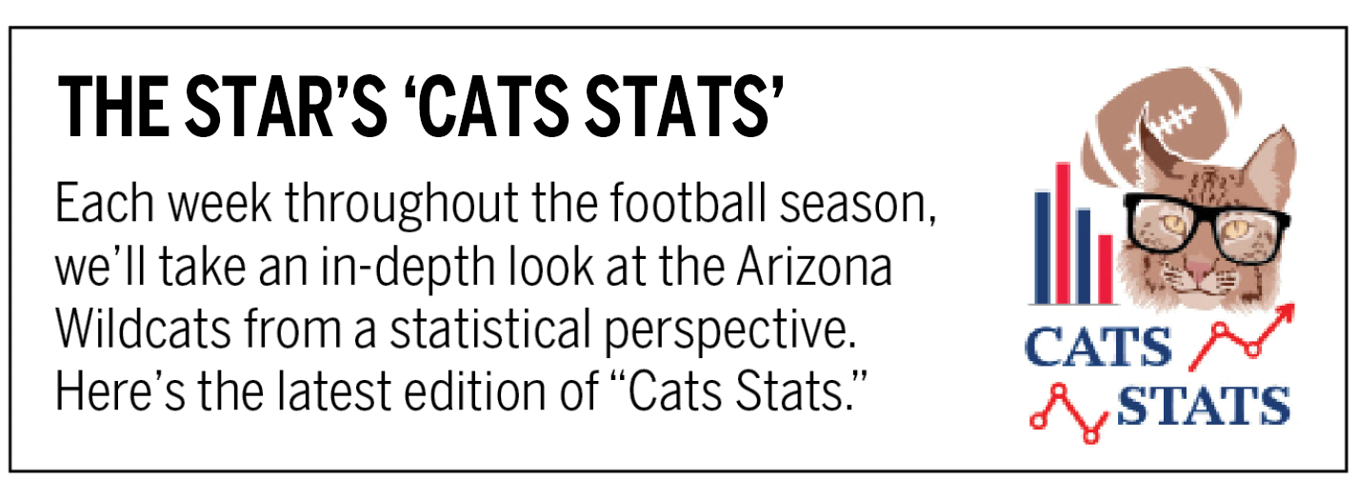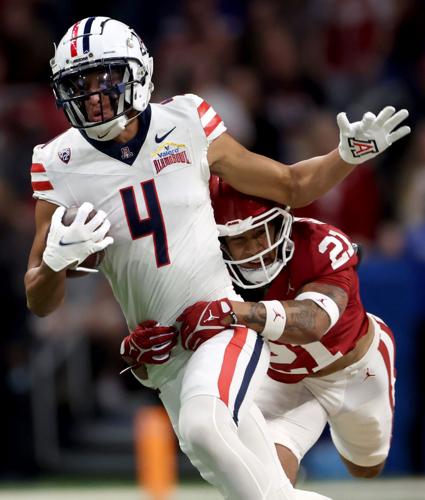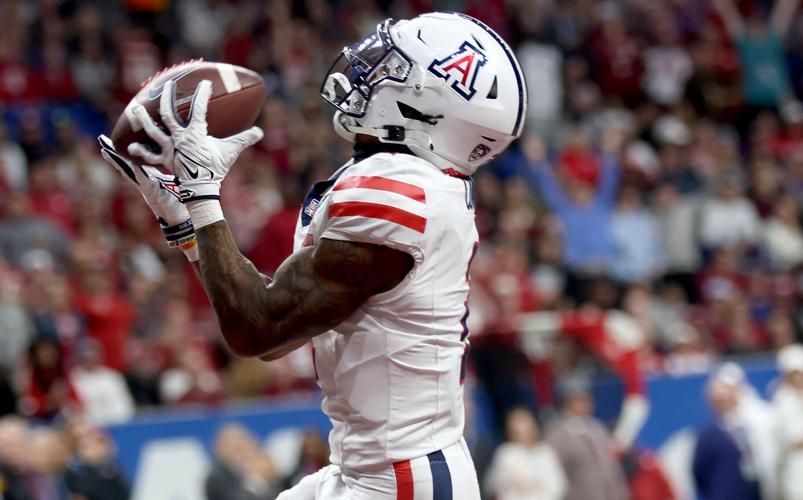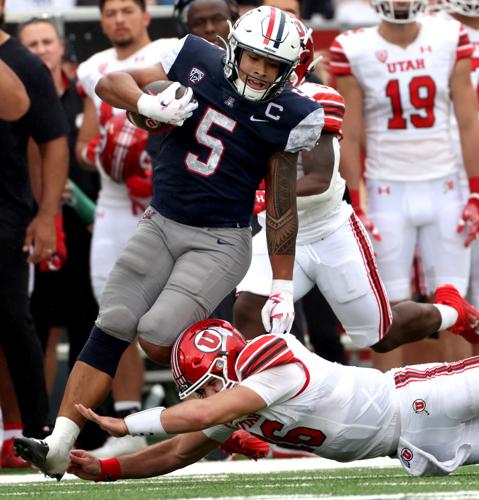In honor of the 2023 Arizona Wildcats’ historic and unexpected 10-win campaign, we present 10 noteworthy numerical nuggets in the season finale of “Cats Stats.”
These statistics highlight team and individual accomplishments that we found especially compelling:

The margins matter
As you surely know by now, this is just the fourth time in program annals that Arizona has won 10 or more games in a season. The Wildcats’ three losses are just as fascinating because they came by a grand total of 16 points — and included two defeats in overtime on the road.
The 1993 club that went 10-2 lost by 20 points against UCLA and by four against Cal.
The 1998 team that went 12-1 lost by that same total — 24 points — against UCLA.
Three of the 2014 team’s four setbacks came by a combined 20 points — but that team also lost by 38 to Oregon in the Pac-12 Championship Game.
Fifita goes deep
One of the few areas where quarterback Noah Fifita struggled after taking over as Arizona’s starter was deep passing.
Heading into the final two games of the season, Fifita had connected on just 8 of 27 attempts (29.6%) of 20-plus air yards, per Pro Football Focus.
In the final two games, he completed just as many — but needed nine fewer attempts to get there. He went 8 of 18 (44.4%) against Arizona State and Oklahoma.
Fifita had more yards (281) and touchdowns (three) on passes of 20-plus yards in those two games than in his previous 10 appearances (245, two).

Arizona wide receiver Tetairoa McMillan drags Oklahoma defensive back Reggie Pearson for an extra yard or two after his one of his 10 catches during the 2023 Alamo Bowl in San Antonio.
T-Mac trending up
Sophomore Tetairoa McMillan finished with the second-most receptions (90) and receiving yards (1,402) in UA history.
But the story of T-Mac’s second season is how much more efficient and multifaceted he became.
McMillan snatched 90 of 130 targets this season — a reception rate of 69.2%. He was under 50% as a freshman (39 of 81, 48.1%).
McMillan also boosted his YAC (yards after catch) per reception by a full yard, from 5.0 to 6.0. He had 195 YAC as a freshman, 536 as a sophomore. His yards per route run jumped from 1.47 to 2.79, per PFF.
Two more via PFF: McMillan’s drop rate fell from 7.1% to 3.2%, and his contested-catch rate rose from 33.3% to 48.3%.

Arizona wide receiver Jacob Cowing pulls in a scoring catch without a Sooner in sight in the first quarter against Oklahoma at the Alamo Bowl in San Antonio on Dec. 28, 2023.
Cowing comes through
Fellow wideout Jacob Cowing matched McMillan’s catch total (90) while setting the school record for touchdown receptions (13). But Cowing’s campaign didn’t kick into high gear until the final two games.
Cowing had 16 catches for 309 yards and three touchdowns vs. the Sun Devils and Sooners.
His average per reception in those two games of 19.3 yards was 12 yards higher than his mark in the first 10 contests (7.3).
Jedd Fisch used Cowing differently than the way he was deployed at UTEP. Cowing’s average depth of target (ADOT) was never lower than 14.8 yards over a full season with the Miners. At Arizona, his ADOT was never higher than 8.4.
Little Jonah, big number
Sophomore running back Jonah Coleman tailed off at the end of the season, in part because of injury (ASU) and in part because of offensive line struggles (Oklahoma).
But Coleman still ranks second nationally in yards after contact per rushing attempt (5.09), per PFF. Only Iowa’s Abu Sama III (6.55) has a higher mark (minimum 59 rushing attempts).
Coleman’s teammates, Michael Wiley and DJ Williams, aren’t exactly easy to bring down. But their YAC/attempt figures (3.43, 2.87) paled compared to Coleman’s.

Arizona center Josh Baker, shown during the UA 2023 season opener against NAU last September, started all 13 games for the Wildcats last season.
The stalwarts
Let’s hear it for Arizona’s iron men up front.
Jonah Savaiinaea, Josh Baker and Wendell Moe started all 13 games. They all played at least 96.9% of the Wildcats’ offensive snaps.
Savaiinaea missed only three plays (889 of 892), per PFF, while manning two positions, right tackle and right guard — sometimes switching between the two in the same game.
The three players were charged with just five combined sacks allowed. Each lined up for at least 528 pass-blocking snaps.
Run ‘D’ is A-OK
Arizona’s defense had its worst two performances against the run in the final two games.
The Wildcats yielded 224 yards against ASU and 201 against Oklahoma. Their previous worst was 146 yards in the triple-overtime loss at USC.
Despite that slippage, Arizona still ranked 27th nationally in run defense entering Monday’s bowl games — an improvement of nearly 100 spots from 2022 (124th).
Arizona allowed 118.2 net rushing yards per game this season — about 90 yards fewer than last year (209.1).
The Wildcats yielded 3.64 yards per rushing attempt, down from 5.59 in 2022.

After throwing an interception to Arizona’s Jacob Manu, Utah quarterback Bryson Barnes saves a touchdown by tripping up Manu in second quarter of the Wildcats’ 42-18 win over the Utes in the final Pac-12 game at Arizona Stadium.
You da Manu!
Arizona’s All-Pac-12 linebacker, Jacob Manu, is a player whose real-world value exceeds what the advanced metrics suggest.
Manu’s overall PFF defensive grade of 65.5 ranks 16th on the team, mainly because of his team-high 21 missed tackles and struggles in pass coverage (78% completion rate allowed).
But Manu invariably finds a way to influence the game.
He led the Wildcats with 40 defensive stops (tackles that constitute a failure by the offense) and tied for the team lead with 36 QB pressures.
Arizona’s leading tackler (116) and second-leading sacker (6.5) also played a team-high 845 defensive snaps.
Gunner’s gains
Has any recent Wildcat experienced a bigger in-season turnaround than safety Gunner Maldonado?
Maldonado appeared to be trending toward a possible benching early in the season. By year’s end, he was the Defensive MVP of the Alamo Bowl.
Maldonado had a hand in seven takeaways over the course of the season — with five of those coming in the final two games.
Maldonado’s average overall PFF defensive grade was 48.3 over Arizona’s first five games. It was 73.9 over the final eight games.
Give and takeaway
Arizona had six takeaways in the Alamo Bowl, its third straight game forcing multiple turnovers.
The last time that happened? The first three games of 2019.
The Wildcats started that year 4-1. Then came the dark days. Arizona didn’t win another game until Nov. 6, 2021.
Just a hunch here, but we don’t see another losing streak following this turnover run. Times have changed. Prosperity has arrived.
VIDEO: Alamo Bowl: Arizona football coach Jedd Fisch delivers his initial postgame remarks after his No. 14 Wildcats’ 38-24 win over No. 12 Oklahoma in the Valero Alamo Bowl on Thursday, Dec. 28, 2023, in San Antonio, Texas. (Courtesy Valero Alamo Bowl)
VIDEO: Alamo Bowl: Arizona Gunner Maldonado, the game’s defensive MVP, discusses how his second-half “pick six” return for a touchdown — it was initially thought to be an interception, but was ultimately ruled a fumble recovery; the touchdown return stood either way — came to develop after the No. 14 Wildcats’ 38-24 win over No. 12 Oklahoma in the Valero Alamo Bowl on Thursday, Dec. 28, 2023, in San Antonio, Texas. (Courtesy Valero Alamo Bowl)








